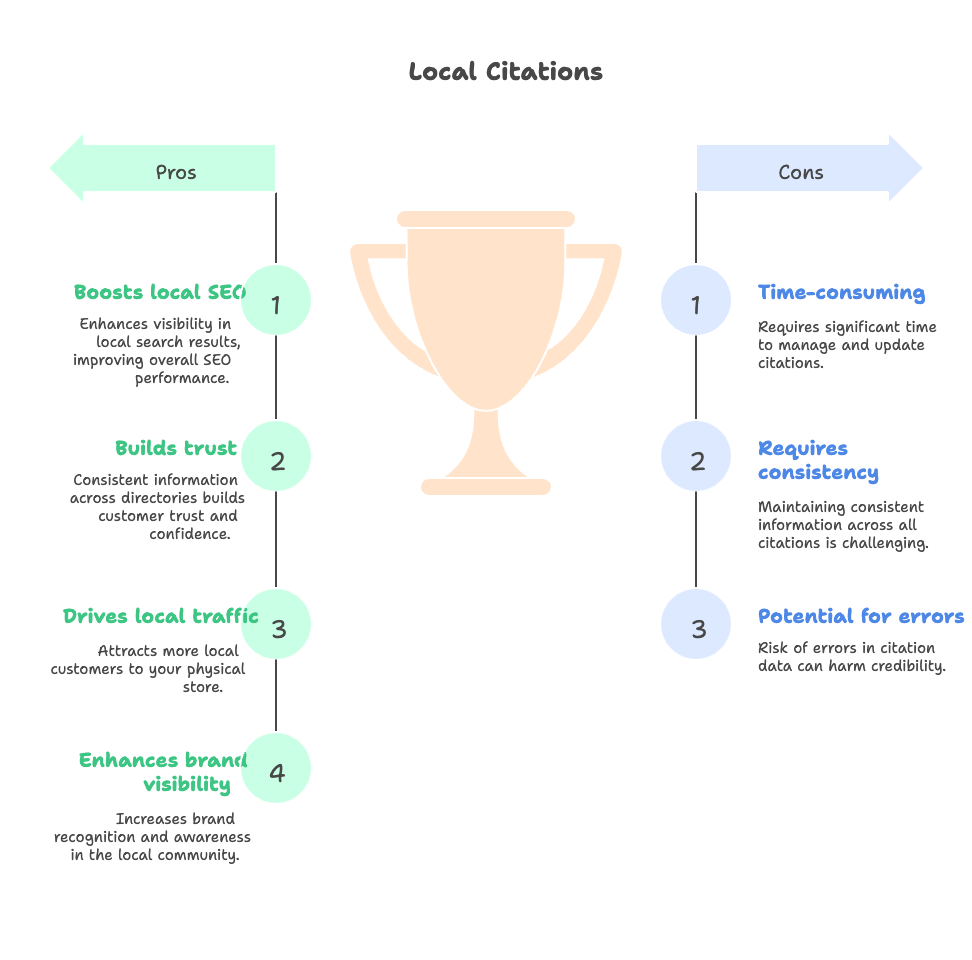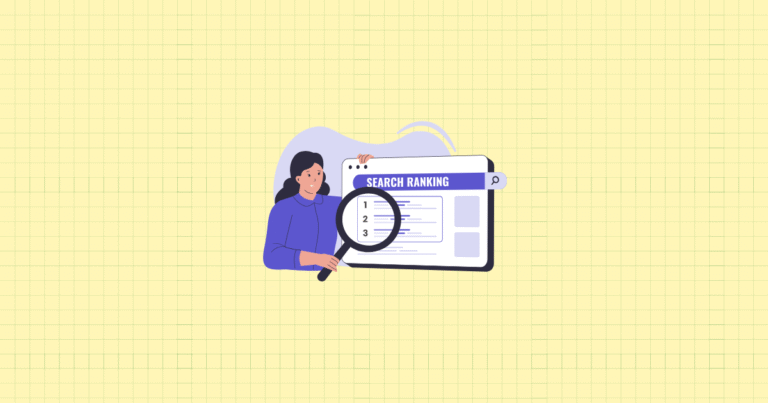Your customer just searched “coffee shop near me” on their phone while walking down your street. Will they find your Shopify store? Or will they discover your competitor three blocks away instead?
For Shopify store owners with physical locations, this scenario plays out thousands of times every day. The difference between being found and being invisible often comes down to something most merchants overlook: local citations.
Local citations might sound technical, but they’re actually simple. Think of them as your business’s digital footprints across the web. When done right, they transform your Shopify store from a hidden gem into a local magnet that attracts both online shoppers and foot traffic. In this comprehensive guide, you’ll discover exactly how to build these powerful citations, avoid common pitfalls, and measure your success as more customers start finding their way to your door.
The Value of Local Citation Building for Shopify Store Owners

Why Local Presence Matters for Shopify Stores
Something remarkable is happening in how people shop. Mobile searches with “near me” have skyrocketed over 900% in the past two years. But here’s what’s even more interesting: these local searches have significantly higher purchase intent than general searches.
When someone types “handmade jewelry near me,” they’re not just browsing. They’re ready to buy. They want to touch the product, meet the maker, or pick up their order today. This presents an incredible opportunity for Shopify merchants who’ve been smart enough to maintain physical locations alongside their online stores.
Your physical location isn’t just a store—it’s a competitive advantage. While pure e-commerce brands struggle with customer acquisition costs and shipping delays, you can offer something they can’t: immediate gratification and personal connection. Customers can browse online, visit in person, and create a relationship with your brand that goes far beyond a transaction.
What Are Local Citations?
A local citation is any online mention of your business’s core information. Think of it as your business’s signature across the internet.
Every citation contains what we call “NAP” data:
- Name: Your business name exactly as it appears on your storefront
- Address: Your complete physical address
- Phone: Your primary business phone number
Citations appear in two main forms. Structured citations live in business directories like Yelp, Google Business Profile, or Yellow Pages—they follow a specific format with dedicated fields for each piece of information. Unstructured citations show up more naturally in blog posts, news articles, or social media mentions where your business details are mentioned within regular content.
The key difference between citations and regular backlinks? Citations focus on your business information and local relevance, while backlinks primarily pass authority and traffic. Both matter, but citations specifically tell search engines where you are and what you do locally.
Why Local Citations Influence SEO
Search engines face a challenge: how do they verify that your business actually exists at the location you claim? Citations provide that proof.
When Google sees your business name, address, and phone number mentioned consistently across dozens of reputable directories, it builds confidence. This consistency becomes a ranking signal for Google Maps and the Local Pack—those three businesses that appear at the top of local search results.
But there’s more to it than just search rankings. Citations build customer trust in ways that might surprise you. When potential customers research your business, they often check multiple sources. Consistent information across directories eliminates confusion and creates confidence. Inconsistent information—different phone numbers or addresses—raises red flags and sends customers elsewhere.
Local SEO Fundamentals for Shopify Stores

Optimizing Your Shopify Store for Local Search
Your Shopify store itself needs to speak the language of local search. This starts with weaving location-specific keywords naturally throughout your site.
Instead of a generic product title like “Artisanal Coffee Beans,” try “Artisanal Coffee Beans in Austin – Free Local Pickup.” This simple change helps search engines understand your geographic relevance while appealing to local customers who value convenience.
Location-specific landing pages transform your single Shopify store into a local powerhouse. Create dedicated pages for each physical location or service area. These aren’t just contact pages—they’re comprehensive local resources.
Each location page should include:
- Unique content about that specific area
- Embedded Google Maps
- Complete NAP information
- Store hours and special local offerings
- Local customer testimonials
- Parking information and local landmarks
Don’t forget the technical side. Shopify makes it easy to add schema markup through your theme editor. LocalBusiness schema tells search engines exactly what type of business you run and where you’re located. This structured data helps your store appear in rich snippets and local search features.
Google Business Profile Optimization
Your Google Business Profile is often the first impression potential customers get of your business. It’s also free, which makes neglecting it particularly costly.
Setting up your profile starts with verification, but that’s just the beginning. The real work happens in the optimization phase. Your business description should clearly explain what you sell and why local customers should choose you. Categories matter more than you might think—choose the most specific category that accurately describes your business.
Photos make or break local search success. Upload high-quality images of your products, storefront, interior, and team. Google heavily weights businesses with complete, regularly updated profiles. Fresh photos signal an active, engaged business owner.
Posts and updates keep your profile alive. Share new products, special events, seasonal hours, or behind-the-scenes content. Think of your Google Business Profile as a mini social media account focused entirely on local discovery.
The Role of Citations in Local Search Ranking
Major Citation Types and Where To Build Them
Not all citations carry equal weight. Some directories command respect from search engines and customers alike.
Start with the essential platforms that every local business needs:
- Google Business Profile – The foundation of local search
- Bing Places – Often overlooked but still drives significant traffic
- Yelp – Crucial for customer reviews and local discovery
- Facebook Business – Where customers check hours and read reviews
- Apple Maps – Growing rapidly with iPhone users
- Yellow Pages – Still relevant for certain demographics
Industry-specific directories often provide higher-quality traffic than general directories. Fashion retailers should prioritize platforms like StyleSeat or local fashion blogs. Food businesses benefit enormously from Zomato, OpenTable, or local food bloggers. Beauty brands should focus on directories like Booksy or regional beauty directories.
Regional directories matter more than many merchants realize. In the United States, platforms like Manta and Superpages carry significant local authority. UK businesses should prioritize Yell and Thomson Local. Canadian merchants benefit from Canada411 and Yellow Pages Canada. Australian businesses find success with True Local and Whereis.
Don’t overlook your local Chamber of Commerce, industry associations, and city directories. These citations often carry exceptional local authority because they’re geographically and professionally relevant.
Benefits of Consistent Citation Building
The compound effect of consistent citations extends far beyond search rankings. Each citation creates a potential entry point for new customers to discover your business.
Map pack visibility changes everything for local businesses. When your Shopify store appears in the top three local results, you’re competing on equal footing with much larger businesses. Customers see your store right alongside national chains, and local businesses often win because of their personal touch and community connection.
Direct referral traffic from directories provides customers who are already in buying mode. Someone browsing Yelp for local businesses has moved past the awareness stage—they’re actively seeking solutions. These visitors often convert at higher rates than general website traffic.
Trust builds incrementally. Every consistent citation reinforces your business’s legitimacy. When customers see the same information across multiple platforms, it removes friction from their decision-making process.
Implementing a Local Citation Strategy on Shopify
Preparing Your Shopify Store Data for Citations
Before building new citations, audit your current online presence. Search for your business name and variations across Google, Bing, and major directories. You might discover listings you forgot about or never knew existed.
Create a master document with your exact business information. This becomes your citation bible—the single source of truth for all future listings. Include:
- Official business name (exactly as it appears on legal documents)
- Complete address with proper formatting
- Primary phone number
- Website URL
- Business description (2-3 versions of different lengths)
- Business categories and keywords
- Hours of operation
- Logo and business photos
Multi-location businesses face additional complexity. Each location needs its own set of citations with unique NAP information. Develop a consistent naming convention like “Your Business Name – Downtown” or “Your Business Name – Mall Location” to differentiate between locations while maintaining brand consistency.
Building and Submitting Citations
Manual citation building requires patience but offers complete control over your business representation. Start with the essential directories listed earlier, then expand to industry-specific and regional platforms.
For each directory, follow this process:
- Search to see if your business already exists
- Claim the listing if it exists, or create a new one
- Complete every available field
- Upload high-quality photos
- Verify the listing through their process
- Set up notifications for reviews and updates
Citation management tools can accelerate this process significantly. Services like Moz Local, BrightLocal, Whitespark, and Yext distribute your information to multiple directories simultaneously. They also monitor for changes and help suppress duplicate listings.
These tools work by connecting to data aggregators—companies that supply business information to hundreds of smaller directories. When you update your information through a management service, it flows down to all connected directories automatically.
For small businesses with single locations, manual building often provides better control and cost-effectiveness. Multi-location businesses or those planning rapid expansion benefit more from automated tools that can manage complex citation networks.
Monitoring and Managing Citations Over Time
Citations require ongoing maintenance. Business information changes—phone numbers update, addresses change, hours shift seasonally. Outdated citations hurt more than help, confusing customers and diluting search authority.
Schedule quarterly citation audits. Search for your business across major directories and check for accuracy. Look for new directories that might have picked up your information from data aggregators. Monitor for duplicate listings that can fragment your local authority.
When changes occur, update your master document first, then systematically update each directory. Start with the most important platforms and work your way down to smaller directories.
Advanced Tactics and Troubleshooting
Powering Up Citations with Local Backlinks and Reviews
Citations provide the foundation, but local backlinks amplify their impact. Seek partnerships with local bloggers, sponsor community events, or contribute expert insights to local publications. These activities generate both citations and valuable backlinks that boost your overall domain authority.
Customer reviews transform static citations into dynamic trust signals. Integrate review collection into your Shopify workflow using apps like Yotpo or Judge.me. Send follow-up emails after purchases encouraging customers to share their experience on Google and other review platforms.
Response management matters as much as collection. Reply to every review—positive and negative. Thank customers for positive feedback and address concerns professionally in negative reviews. This engagement signals to both search engines and potential customers that you’re actively managing your business reputation.
Handling Common Citation Issues
Duplicate citations split your local authority and confuse search engines. Use citation audit tools to identify duplicates, then work systematically to merge or remove them. Most directories provide processes for claiming and correcting listings, though some require persistence.
NAP inconsistencies create the most common citation problems. Small variations like “Street” vs “St” or different phone number formats can fragment your local authority. Establish strict formatting standards and apply them consistently across all platforms.
Rebranding or moving locations requires careful citation management. Update your master document first, then prioritize high-authority directories before tackling smaller platforms. Consider keeping old listings active briefly with forwarding information to avoid losing established authority.
Measuring Success and Continuous Improvement
Key Metrics to Monitor Citation Impact
Local search rankings provide the most direct measure of citation success. Track your position in Google Maps and the Local Pack for your primary keywords. Use tools like BrightLocal’s Local Search Rank Checker or manually search from different devices and locations.
Directory referral traffic tells you which citations drive actual customers. Check your Shopify analytics for traffic from Yelp, Google Business Profile, and other directories. High-quality citations should generate both traffic and conversions.
Review volume and sentiment often improve alongside citation building. As your local presence strengthens, more customers discover and review your business. Monitor review trends across platforms to gauge local reputation growth.
Refining Your Shopify Local Citation Strategy
Competitor analysis reveals new citation opportunities. Use tools like Whitespark’s Local Citation Finder or BrightLocal’s Citation Tracker to see where your competitors are listed. Look for industry-specific directories or regional platforms you might have missed.
Local search evolves constantly. New directories emerge, algorithms change, and customer behavior shifts. Stay connected to local SEO communities and adjust your strategy based on emerging trends and opportunities.
The most successful Shopify merchants treat citation building as an ongoing process, not a one-time project. Regular maintenance and strategic expansion create compound benefits that accelerate local business growth.
Conclusion & Next Steps
Key Takeaways for Shopify Store Owners
Local citations bridge the gap between your online Shopify store and offline success. They validate your business location, build customer trust, and create multiple pathways for local discovery. When executed consistently, citations transform your physical location from a cost center into a customer acquisition engine.
The impact extends beyond search rankings. Citations create a comprehensive online presence that supports both digital marketing and in-person sales. They help customers find you, trust you, and choose you over competitors who haven’t invested in local visibility.
Action Plan for Immediate Implementation
Start with a complete audit of your current online presence. Document all existing listings and identify inconsistencies that need correction. This foundation work prevents future problems and maximizes the impact of new citations.
Focus on the essential directories first: Google Business Profile, Bing Places, Yelp, and Facebook Business. Complete these thoroughly before expanding to industry-specific or regional directories. Quality beats quantity in citation building.
Implement ongoing monitoring and update processes. Citation building isn’t a one-time project—it’s an ongoing commitment that compounds over time. Regular maintenance and strategic expansion create sustainable local search advantages that drive both online and offline growth.
The merchants who succeed with local citations treat them as part of a comprehensive local marketing strategy. They understand that every citation is an opportunity to connect with local customers and build the community presence that makes their Shopify store not just another online retailer, but a valued local business.
References
- Senna Labs. “Local SEO for Shopify Stores: Attracting Nearby Customers.” December 2024. https://sennalabs.com/blog/local-seo-for-shopify-stores-attracting-nearby-customers
- Shopify. “What Are Local Citations? How To Boost Local Search Visibility (2025).” June 2025. https://www.shopify.com/blog/local-citations
- Shopify. “Local SEO: What It Is and How To Do It (2024).” December 2023. https://www.shopify.com/retail/local-seo-retail
- Applabx. “Local SEO for Shopify Stores: Attract More Customers in Your Area.” June 2025. https://blog.applabx.com/local-seo-for-shopify-stores-attract-more-customers-in-your-area/
Ready to supercharge your Shopify store’s local visibility and drive more foot traffic to your physical location? Growth Suite is a free Shopify app that helps you optimize every aspect of your customer acquisition strategy. While you’re building citations to attract local customers, Growth Suite intelligently converts more of your website visitors into paying customers through perfectly timed, personalized discount offers. Install it with a single click and start seeing results immediately—because the best citation strategy works even better when you’re converting more of the traffic it generates!




